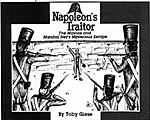

Author: Toby Giese
Pages: 76
Illustrations: 74 black and white reproductions of period paintings and some original illustrations.
Maps: 1, a map of Paris in 1815
Footnotes: None
Appendices: None, but there is a summary of the thirteen chapters, a calendar of events, and a table outlining fifteen "questions" supporting the book's thesis
Bibliography: 17 sources cited, plus other references noted in a chapter called "Credits, References, and Research."
Index: None
Publisher: Toby Giese (self-published), Kansas City, Missouri
Publication Date: 1989
Binding: Paper (softbound)
ISBN: 0-9623241-0-8
Price: $18.00 + $2.50 shipping in the U.S.
Summary: Those who enjoy conspiracy theories and are suspicious of official versions of history might find this book to be an interesting story. However, the evidence is not always presented well, and there are inconsistencies in the documentation to support the author's allegations that Marshal Ney's execution was faked and with the help of the Freemason brotherhood he escaped to America.
Toby Giese researched a wide variety of material, wrote the text, and drew some of the illustrations for this one-man publishing effort. An editor and other professional touches could have raised this book from its amateur level, although there is a certain charm in the effort of an enthusiastic novice.
The premise of this small book is that Marshal Michel Ney, whom Napoleon called the "Bravest of the Brave," narrowly avoided execution after Waterloo by Louis XVIII who was seeking revenge against the officers who defected to Napoleon when the deposed Emperor returned from exile on Elba.
Giese presents six "clues" to support his story. First, Ney should have fallen backward when shot by the firing squad. Instead, he fell forward and lay face down, probably to disguise the fact that he had not been hit. Second, there was no coup de grace of a bullet to the head as a military execution is supposed to end. Third the Duke of Wellington may have been involved in helping to set up the deception and escape. Four, the "blood" samples retrieved from the execution site supposedly did not test positively as real blood. Five, a man on a ship bound for the United States shortly after the execution thought he recognized Ney on board. Finally, there are examples of handwriting by Marshal Ney and a Peter Stuart Ney who was a school teacher in North Carolina which Giese feels look too similar to be coincidence.
Although not presented as clues, Giese's other evidence includes the testimonies of several people who said they either recognized the former French Marshal in America, or that Peter Stuart Ney confessed to them that he was Michel Ney. One of these witnesses includes a Dr. E. M. C. Neyman who claimed to be Ney's son. He had changed his name to Neyman sometime after he was sent to America by his mother.
There is a potentially fascinating story here, but it was frustrating to read so many unsubstantiated conversations, including several that were clearly fictitious. Fabricating quotes of what Ney or others might have said in private only hurts Giese's arguments. There were also annoying errors, such as referring to the 1812 Prussian campaign and 1814 Russian campaign (which should have read 1806 and 1812, respectively), calling Ney "Field" Marshal, etc., served only to distract this reviewer from the story.
Although there are documents cited, the lack of footnotes and index makes it almost impossible to verify the "facts" and quotes used by Giese to bolster his hypothesis. Because of its weaknesses, instead of a hard-hitting expose, the book is reduced to a very readable yarn.
Other Book Reviews
- The Culture of Clothing: Dress and Fashion in the Ancien Regime
- The Art of Dress: Fashion in England and France 1750-1820
- As Befits a Legend: Building a Tomb for Napoleon
Back to Table of Contents -- Napoleon #5
© Copyright 1996 by Emperor's Press.
This article appears in MagWeb (Magazine Web) on the Internet World Wide Web.
The full text and graphics from other military history magazines and gaming magazines are available at http://www.magweb.com